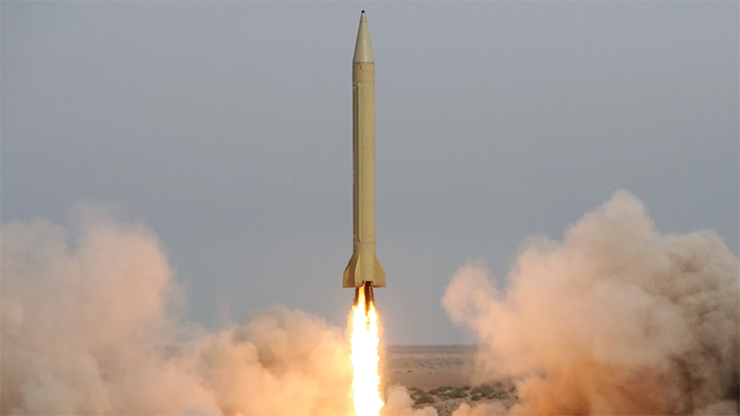
Tel Aviv: Satellite images show Iranian preparations for a launch into space. Israeli experts say that this is another step in the development of this country’s long range ballistic missile capability.
On February 2, 2008, Iran became the ninth space-faring nation when it successfully orbited its first satellite, the “Omid” by its newly developed “Safir” space launch rocket, an adaptation of the “Shahab 3” military ballistic missile.
According to Dr Uzi Rubin, one of the Israeli senior experts on ballistic missiles, in 2008, the world was treated to the debut of Iran’s first solid propellant space rocket. He adds that this is highly significant. Unlike liquid propellant rockets that need to be fuelled before launch, solid propellant rockets are launch-ready at any time.
Rubin says that the first disclosure of the existence of a new space launcher was made by Iran’s Mehr news agency on February 9, 2020 when it announced the completion of the design of a new solid propellant Space Launch Vehicle (SLV) dubbed “Zuljanah” scheduled to make its first flight in June of that year.
“Hence, most of the world’s ballistic missiles use solid propellants. The new Iranian space rocket was launched into a suborbital trajectory from Semnan space port. The new space launcher was dubbed “Zuljanah” after the mythical horse of Husain Ibn Ali, the first martyr in the cause of Shia Islam who died in 680 AD. More than millennia later, his faithful mount was honoured by an emblem of a winged horse painted on the side of the new rocket.”
The new Zuljanah lifted off from it launch pad on February 2, 2021, seven months later than the Mehr news agency announcement but still within the current Iranian year, as promised by Hatami. No satellite was inserted into orbit. Some reports said that the rocket reached an altitude of 320 km. This might have signified a failure to reach earth orbit. More likely, no satellite launch was intended. Rather, this first flight of the new space launcher was a preliminary suborbital flight test to check out flight characteristics and the launch sequence rather than an audacious leap into a fully-fledged space shot.
The Zuljanah is Iran’s first solid propellant SLV, sporting the largest solid propellant motors yet revealed by Iran. The released video clips show a smooth take-off from a launch table equipped with a large jet deflector firmly fixed to the launch pad’s surface. The video clip shows the rocket shortly before take-off, with the launch support tower already reclining out the rocket’s way. An enthusiastic announcer intones a long introduction, invoking God’s name and counting down from ten to zero. Curiously enough, nothing happens at the count of zero. Unfazed, the announcer switches from count-down to count-up, with ignition of the first stage occurring at zero plus ten seconds. Was it a malfunction? It is hard to say. Perhaps ignition at zero plus ten was preplanned, for unknown reasons. In any case, the video shows a smooth lift-off and steady climb into a curving trajectory. After approximately sixty seconds, there is a fadeout and the video ends. There is no indication whether the second stage separated or ignited. This may indicate that the second stage was not ignited in this test, either intentionally or because of some malfunction; otherwise, the Iranians would have highlighted the stage separation and second stage ignition in their released video. Interestingly enough, this time no transmissions from on-board cameras were released, as the Iranians love to do with most of their ballistic missiles and space launcher flights. The impression is that the whole exercise was dictated by the symbolic deadline of February 2, rather than by the need to maximize the effectiveness of the flight test. The Iranians launched whatever was ready by that date, which might have been a rocket with a live first stage but dummy upper stages, with no time for frills like on-board cameras.
According to Rubin, the “Zoljanah” represent a departure from Iran’s hitherto cautious policy of not provoking the West by brandishing its capability to produce missiles that could reach Europe. Iran’s second generation SLV, the liquid propellant “Simorgh,” is not a good candidate for producing a derivative intermediate range ballistic missile (IRBM) or intercontinental ballistic missile (ICBM), due to its complexity and the cumbersome method of its launching.
The solid propellant “Zuljanah” is a different story. A ballistic missile using its two huge solid propellant stages could probably deliver payloads of 500 kg or so to ranges of 4000 km or more – enough to reach all of Europe. In other words, the Zuljanah is a candidate precursor for a ready to launch, survivable IRBM aimed at the core members of the EU. Moreover, the official Iranian release mentioned that the “Zoljanah” could be fired in the future from mobile launchers; a capability more appropriate for a military IRBM than a peaceful civilian space launcher. The impression is that the Iranian leadership is stretching thin the cover story of its “civilian” space program, in tandem with stretching its compliance with the Nuclear Deal, to accumulate bargaining chips for its forthcoming negotiation over the US return to the nuclear deal. At this time, Iran’s nuclear transgressions are reversible, and can be bargained away against the lifting of Trump-imposed sanctions. Similarly, Iran’s abrogation of its own self-imposed upper limit of 2000 km. on its missiles range, as implied by the Zuljanah’s potential to be turned into an IRBM, can be easily reversed as an implicit concession to European sensitivities.
Israel defence sources told Raksha Anirveda that the Iranian space program is directly connected to its long range ballistic missiles program and should be an issue of big concern like this country’s nuclear program.








